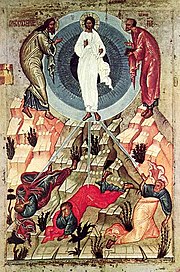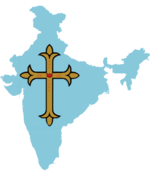
Mother Mary Teresa Bojaxhiu, honoured in the Catholic Church as Saint Teresa of Calcutta, was an Albanian-Indian Roman Catholic nun and missionary. She was born in Skopje, then part of the Kosovo Vilayet of the Ottoman Empire. After living in Skopje for eighteen years, she moved to Ireland and then to India, where she lived for most of her life.
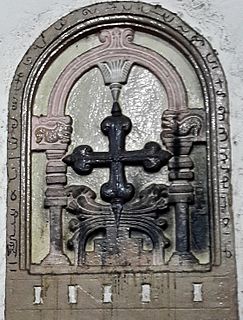
The Syro-Malabar Catholic Church, is an Eastern Catholic Major Archiepiscopal Church based in Kerala, India. It is an autonomous particular church in full communion with the pope and the worldwide Catholic Church, with self-governance under the Code of Canons of the Eastern Churches (CCEO). The Church is headed by the Metropolitan and Gate of all India Major Archbishop Mar George Cardinal Alencherry. The Syro-Malabar Synod of Bishops canonically convoked and presided over by the Major Archbishop constitutes the supreme authority of the Church. Officially known as the Syro-Malabar Church, Syro-Malabar is a prefix coined from the words Syriac as the church employs the East Syriac Rite liturgy, and Malabar which is the historical name for modern Kerala. The name has been in usage in official Vatican documents since the nineteenth century.

Kuriakose Elias Chavara, C.M.I. was an Indian Catholic priest and social reformer. He is the first canonised Catholic male saint of Indian origin and belongs to the Syro-Malabar Catholic Church, an Eastern Catholic Church based in the state of Kerala. He was the co-founder and first Prior General of the first congregation for men in the Syro-Malabar Catholic Church, now known as the Carmelites of Mary Immaculate (C.M.I.), and of a similar one for women, the Congregation of the Mother of Carmel (C.M.C.).he is a pioneer in many fields

Bharananganam, an important pilgrimage centre in South India, is located on the banks of the Meenachil River, 5 km away from Pala and 4 km from Plassanal, in Kottayam district in the state of Kerala. Bharananganam and surrounding places are hilly areas with a lot of vegetation. Agriculture is the main occupation of the people, who cultivate plantation crops such as rubber.

The Marthoma Nazrani Archeparchy of Changanacherry is a Syro-Malabar Catholic archeparchy with an area of 24,595 km2 comprising the districts of Kottayam, Alappuzha, Pathanamthitta, Kollam, and Thiruvananthapuram in Kerala, and also Kanyakumari district in Tamil Nadu. It is one of the largest Catholic dioceses in India in terms of area. Mar Joseph Perumthottam is the current Metropolitan Archbishop, serving since 2007. Mar Thomas Tharayil has been the auxiliary bishop since 2017. And Mar Joseph Powathil is the bishop emeritus, having served from 1985 to 2007. Suffragan eparchies of the Changanassery archeparchy includes Palai, Kanjirappally, and Thuckalay.
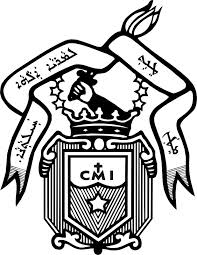
The Carmelites of Mary Immaculate (C.M.I.) is a scholarly religious congregation of the Catholic Church, and is the largest clerical religious congregation of pontifical right in the Syro-Malabar Catholic Church.
Rev. Dr. James Kalacherry was an Indian educationalist and bishop of the Syro-Malabar Catholic Church, taking charge of the Diocese of Changanassery.

This is a timeline of the history of the Syro-Malabar Catholic Church in India.
Ludovico of Casoria - born Arcangelo Palmentieri - was an Italian Roman Catholic priest and a professed member of the Order of Friars Minor. He was a renowned social reformer who founded both the Grey Friars of Charity and the Grey Franciscan Sisters of Saint Elizabeth.

Payyappilly Varghese Kathanar was a Syro-Malabar priest from the Indian state of Kerala and the founder of the congregation of Sisters of the Destitute. He was declared Venerable by Pope Francis on 14 April 2018.
Euphrasia Eluvathingal was an Indian Carmelite nun of the Syro-Malabar Church, which is an Eastern Catholic Church in Kerala. Euphrasia is said to have had a vision of the Holy Family, at which point the illness she had long felt ceased. She was canonised as a saint by Pope Francis on 23 November 2014 in Vatican City. Since the beheading of St. John the Baptist is celebrated on August 29, the feast of St. Euphrasia is postponed to August 30.
The Congregation of the Mother of Carmel (C.M.C.) is a Syro-Malabar religious institute of Discalced Carmelite Religious Sisters founded in 1866. It was the first native congregation for women in that Church.

Gimi George, better known by her stage name Miya George(Born on 28'th January 1992) is an Indian actress and model who predominantly works in Malayalam cinema, along with a few Tamil films. She started her career as an actress by playing supporting roles in television shows. She made her film debut by playing short roles in films such as Oru Small Family (2010), Doctor Love (2011) and Ee Adutha Kaalathu (2012). She was selected the Kerala Miss Fitness in 2012 and played her first lead role the same year in the Malayalam film Chettayees. She's best known for her roles in the films Memories (2013), Vishudhan (2013), Mr. Fraud (2014), Amara Kaaviyam (2014), Indru Netru Naalai (2015), Anarkali (2015), Paavada (2016), Hello Namasthe (2016), Oru Naal Koothu (2016), The Great Father (2017), Sherlock Toms (2017), Ira (2018), Ente Mezhuthiri Athazhangal (2018), Brother's Day (2019), and Driving Licence (2019).

The Marthoma Nazrani Eparchy (Diocese) of Palai is a Syro-Malabar Catholic eparchy with an area of 1166 km2 comprising the Meenachil taluk and a few villages of the neighbouring taluks in Kottayam, Ernakulam, and Idukki districts of central Kerala in South India. The faithful of this eparchy, numbering 326,742, belong to the ancient St. Thomas Christian community. The seat of the bishop is the St. Thomas Cathedral based in the town of Palai. The current bishop is Mar Joseph Kallarangatt, serving since March 2004. Mar Jacob Muricken has been auxiliary bishop since 2012.
Rajiv Vijay Raghavan is an Indian director, script writer, and producer. Margam (film), his debut future film, that received national and international recognition, placed him as one of the authentic voices in the art film movement of Indian Cinema and that of Malayalam cinema during 2000s. He had also made a number of award-winning and socially relevant documentaries. Trained in the Film & TV Institute of India, Pune, and assisted G. Aravindan, the great filmmaker of 20th century Indian Cinema.
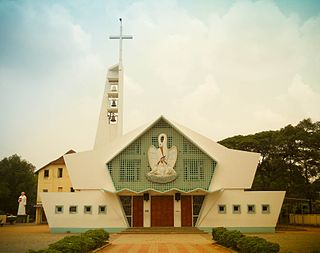
St. Philomena's Forane Church, popularly known as Koonammavu Church is situated in Koonammavu, a northern suburban town of Kochi City of Kerala state, India. This is one of the oldest Roman Catholic churches in India, built in 1837 AD. Even though the church is dedicated to the Virgin Philomena, Saint Chavara Achan's feast is celebrated in every year as the annual festival, a nine-day festival lasting from 26 December to 3 January along with Holy Christmas and the New Year. The church is also popular among non-Christians as a pilgrimage centre and this seventh Forane of Roman Catholic Metropolitan Archdiocese of Verapoly serves as the Catholic Forane Church of 12 churches listed below.
- Church of Our Lady of Velankanni, Chariyamthuruth
- Christ the King Church-Christnagar,Varapuzha
- St. Antony's Church, Kongorpilly, Koonammavu.
- Church of Our Lady of Rosary, Maloth, Koonammavu
- Church of Our Lady of Nativity, Muttinakam, Varapuzha
- St. Joseph's Church, Neerikode, Alangad.
- Little Flower Church, Panayikulam
- Sacred Heart Church, Thevarkad, Varapuzha.
- Infant Jesus Church, Thundathumkadavu, Varapuzha.
- Amalolbhavamatha Church, Valluvally, Koonammavu
- Our Lady of Mount Carmel and St Joseph's Minor Basilica,Varapuzha
- St. Antony's Church,Chennur, Varapuzha.

St. Joseph's Church, Mannanam is a Syro-Malabar Catholic Church located in Mannanam, Kerala. The church was built by St. Kuriakose Elias Chavara on top of a hill and his mortal remains are interred in the church.
Lissy Vadakkel is an Indian Roman Catholic nun and member of the Franciscan Clarist Congregation. She is a key witness in the rape case against Bishop Franco Mulakkal.

